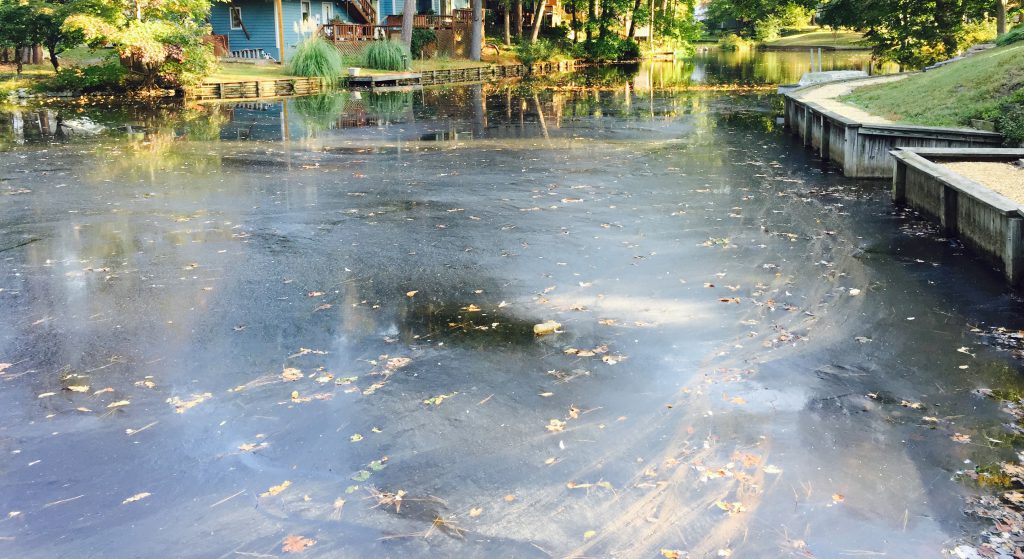Pond Biofilms
 You may have noticed a clear or iridescent film on the surface of your pond, and you may be alarmed at first sight. But don’t panic! This could be several different things and may be simple to resolve!
You may have noticed a clear or iridescent film on the surface of your pond, and you may be alarmed at first sight. But don’t panic! This could be several different things and may be simple to resolve!
Often, the film is mistaken for algae; these are small particles which clump together and can cause green or slimy water. Often the algae sits on the surface of the pond and can create a film over it. An easy way to tell the difference if it is algae (or a ‘biofilm) is to wave a stick through the pond. If there are any oils in the pond, the oil will swirl back on itself, whereas a ‘biofilm’ will fracture into smaller pieces. If the film is green coloured, then it is likely to be algae, but if the film is not green, it is likely to be a ‘biofilm’.
What is a biofilm? (Useful Blogs: Why Temperature plays a big role in Pond Development, Green Water and Slimy Algae, Common Pond Discolouration Problems, Water Quality)
Surface biofilms are not caused by algae or hydrocarbons (oils), but normally caused by bacteria (or pathogens) that are in the presence of a lot of decaying organisms. The biofilm is common for water sources because it is caused by bacteria, but it is an uncommon problem for pondkeepers to have and, unfortunately, not a lot of research has been done on the causes and treatments.
What we do know is that biofilms can form on the surface when organisms in the pond (plants, fish, wildlife etc) die at a faster rate than the healthy bacteria are able to decompose it. Basically, there’s too much decaying material in the pond and the bacteria cannot remove it quick enough. The biofilm is normally worse in the summer (because of the warmer temperatures) or if the pH in a pond is low. In general, if your pond has a biofilm on it, then it is likely that the water quality is poor and unbalanced and should be resolved as quickly as possible.
How can you treat a biofilm? (Useful Blogs: Water Quality, Pond Sludge, Bacteria, How to Oxygenate a Pond, Benefits of UV Filtration in your Pond, Pond Plants)
.jpg)
We would also recommend trying to remove any decaying organisms in the pond while also increasing the levels of healthy bacteria in it.
• Removing Sludge: You should try to use a cover net, vacuum, or a sludge net to prevent surface debris. You can also use sludge nets to manually remove sludge from the bottom of the pond, though some people prefer using an electric pond vacuum. After manually removing as much as possible, a treatment like the PondXpert Sludge Eliminator should help to clear up the remaining sludge.
• Adding Bacteria: You can use the PondXpert Gel Balls and Evolution Aqua Pure Pond Bombs to improve the levels of bacteria in the pond. Alternatively, the PondXpert Filter Start Gel or Evolution Aqua Filter Start Gel can be used to allow the bacteria to quickly colonise your filter, greatly improving healthy bacteria levels.
• Improve aeration: Improving the levels of 'bottom aeration' seem to have a big impact on biofilm generation. This is likely due to the natural levels of bacteria and water quality improving with proper oxygen levels, which aids in decomposition and prevents the spread of diseases and infections in the pond. Easy ways to improve aeration include installing a fountain, waterfall, Pond Plants, or an air pump.
• Improve UV Clarification: All fish ponds should have some form of UV filtration, whether it is an integrated UV bulb in your filter or a separate unit that is located between your pump and filter. The role of a UV clarifier includes binding algae particles together so they clump up (or 'flocculate'). Once big enough, the clumps of algae are removed by the filter foams. But a UV clarifier can also kill certain types of dangerous bacteria, fungal infections or diseases, which helps to reduce the unhealthy bacteria which causes a biofilm.
By removing the sludge and improving the amount of healthy bacteria and aeration in your pond, you should be adjusting the balance in favour of the bacteria. This should certainly help to prevent the biofilm from getting worse and should improve the water quality; though due to the lack of research, there is no quick fix.
If you have any queries, please email us on info@pondkeeper.co.uk.